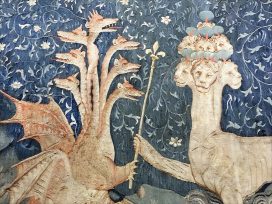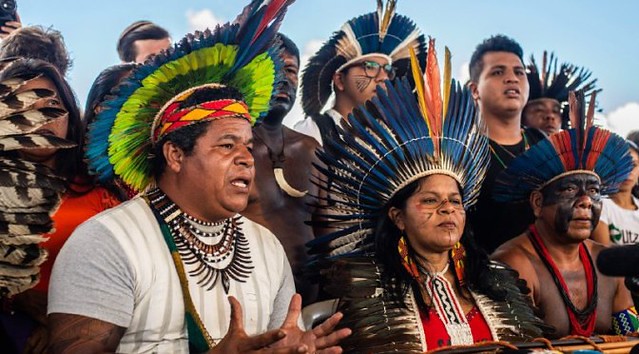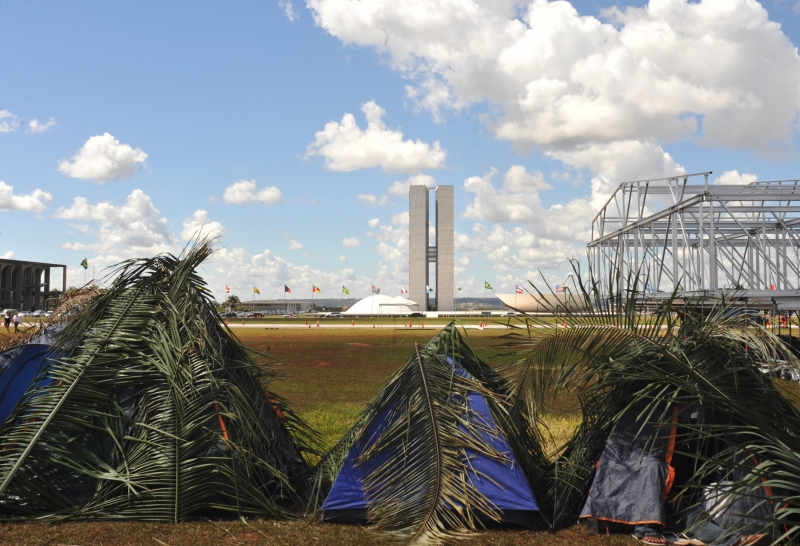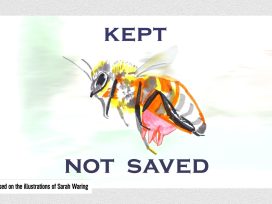
The visions of an apocalypse peddled by nihilistic humanists and misanthropic transhumanists confuse the destruction of humankind with salvation.
Speaking out about capitalism’s ‘accumulation by dispossession’ – the desperate need to stop the industrial-sized devastation of rainforests, directly affecting Brazilian indigenous people, indirectly affecting everyone.
When we think about property, we tend to imagine buildings, physical means of production, or defined land areas. These images of property, however, may be challenged by other forms of resource use, for example when land is used for living, rather than simply owned. Different understandings of property may clash when someone claims ownership of a specific piece of land, or when someone uses the land in a way that hinders others from using it. Throughout history, we have seen these types of contradictions play out all over the world.
Perhaps the most notable case is that of colonization. Communities that have resided in certain territories for generations have faced major restrictions in land use when colonizers have dispossessed them of great areas of land. These historical processes of land acquisition extend into the present. We find ourselves in a ‘postcolonial’ predicament, supported in various ways by capitalist states through the promotion of incentives for land to provide as much financial return as possible. This text is about resistance to this ongoing colonialism.

Articulação dos Povos de Indígenas do Brasil (APIB). Image by Divulgação via Flickr.
In October 2019, Fronesis had the opportunity to speak to Sônia Guajajara, a representative of the Brazilian indigenous movement Articulação dos Povos de Indígenas do Brasil (APIB), during her visit to Sweden. The visit was a part of the European tour she undertook to raise awareness of and advocate against the trade agreement that came into effect in July 2019 between the EU and the South American trade bloc Mercosur. During the tour, fifteen representatives of APIB visited twelve European countries under the slogan ‘Indigenous people – Not one more drop of blood’.
Sônia Guajajara belongs to the Guajajara people, one of many indigenous groups in Brazil. The Guajajara people have resided in the forest areas around the Pindaré river since pre-Columbian times. The area was conquered by the French in 1611 and taken over by the Portuguese in 1614. Their main settlement, São Luís do Maranhão, was located very strategically on the Island of Maranhão at the mouth of the river system of the Pindaré, Grajaú and Merim rivers. From there the Portuguese could easily navigate the area, allowing for rapid colonization of both land and labour power.
The subsequent history is filled with confrontations between indigenous people on one side and colonizers and their descendants on the other. Though Brazil declared independence from Portugal in 1822, the colonizing process has continued to this day in the cultural and physical displacement of indigenous people. In this form of colonization, it is no longer colonizers from other countries who exploit the land – rather, the conflict is waged between internal groups.
One such internal confrontation was the uprising of 1901, when Guajajara people revolted against Christian missionaries who for many years had been kidnapping Guajajaran children to put them in missionary schools.1 A more recent conflict took place in the same area in São Pedro dos Cacetes, a town that had been illegally settled by descendants of Europeans in the 1950s. In 1979, after the settlers had killed nine pregnant Guajajaran women, the federal government decided to relocate them and leave the area for the Guajajara people.2 This plan had not yet been realized in 1992 when the conflict reached its apex – then, the Guajajara people took nearly 400 people hostage to claim their right to the land.3 In the end, the Minister of Justice himself negotiated an agreement whereby the Guajajaran people let the hostages go in exchange for the federal government agreeing to relocate the citizens of São Pedro dos Cacetes to areas outside the territory. This promise was only fully realized by the Brazilian state in 1995, almost 50 years after the area was first occupied.4
Once, 110,400 km² of the Maranhão state was covered by rainforest. Now, only 25% of the rainforest remains. The rest has been cut down mainly to provide space for agriculture and cattle ranching. The deforestation rate accelerated markedly in the 1960s when the country’s military regime created incentives for large-scale farming on public land and the construction of highways, which led to an increase in population due to migration, and later railways and other forms of infrastructure to support the mining industry.5 One key factor in these state interventions was that land that was viewed as unproductive – including land traditionally used by indigenous people – could easily be expropriated by the state and put in the hands of big farmers who, according to the state, could use the land in more ‘efficient’ ways.
The situation can be seen as a case of what Karl Marx calls ‘primitive accumulation’, a process in which the economic system expands to areas that have previously not been exposed to capitalist structures, with a view to accessing new labour, new natural resources and new markets.6 The Marxist economic geographer David Harvey has developed the concept further to describe continuous accumulation that builds on these principles as ‘accumulation by dispossession’.7 Here, dispossession can be understood as both the direct expropriation of land and the dispossession of indigenous people’s means of continuing to live according to their traditions. This accumulation by dispossession has in many ways been facilitated by the Brazilian government. Expropriating land, the state has controlled and distributed it in ways intended to optimise economic development.
We begin our interview with Sônia Guajajara by discussing why the Guajajara people are not granted the right to the land where they live. Here she raises the idea of unproductivity as a key concept in the state’s legitimization of the exploitation of their land:
All of this, this thirst for exploitation, is the result of a greed that has its roots in capitalism. I don’t doubt that it is capitalism that creates this. To not respect people, to destroy the environment for one’s own use. All in the name of profit. Yes, capitalism threatens the green areas, the pristine lands. And it doesn’t matter what type of nature is concerned, the Amazon, Cerrado, Mata Atlantica – anything, because if these areas are preserved they are seen as unproductive.
All of it needs to be devastated to farm, and make money. Because what matters is what you get out of it, not what it means for the planet. So we have increasingly been fighting an urgent struggle against this economic system, which builds on large-scale production and exploitation. This system, with farming companies that set up monocultures and pastures, is not sustainable. It is necessary to stop it.
This development has not only affected indigenous people who have been displaced from their territories. It has also affected small-scale farmers and landless peasants using land that they do not own. In the 1960s small-scale farmers were given strong incentives to cut as much forest as possible on their pieces of land in order to prove that they were used, so that they would not be deemed unproductive and therefore be expropriated. At the same time, large areas of land were confiscated and sold to large-scale farmers. This was supported by the World Bank, which together with other major trade organizations made great investments in Brazilian livestock farming during the 1960s and 1970s.
As a result of these processes, large parts of the usable land were concentrated in the hands of large-scale farmers, while many small-scale farmers lost their land. Poverty drove these landless peasants to occupy large tracts of land and cut down forests illegally, which led to great and long-lasting conflicts between the landless and the large-scale farmers, but also between landless peasants and indigenous peoples, who were forced to fight over the same land.8

Free Land Camp, The Articulation of Indigenous Peoples of Brazil (APIB). Image via Wikimedia Commons.
One of the most recent occasions on which this battle developed into a bloody conflict was connected with the murder of Paulo Paulinho Guajajara. Paulinho was a leading figure in the group ‘Guardians of the Forest’, which organizes patrols against illegal deforestation in the area of Arariboia, a reserve in the Amazon where Guajajara people live. He was shot during a clash with illegal loggers in early November 2019. Just a few weeks later, two more front figures for the Guajajara people were assassinated, and in April 2020, another indigenous leader was assassinated, all three after standing up to illegal logging in various ways. The Guajajara people’s fight for the right to their territories has often involved defending areas with their bodies. Sônia Guajajara believes this kind of struggle is unique to the indigenous movement:
Precisely because we are an indigenous people, we have our own way of waging a lasting struggle. For us, it is a way of life. And this is closely linked to our own way of using the weapons we have and defending the territories and waging a struggle with our own bodies. We do not defend anything or anyone else, but our body is the territory, our body is the environment.
While now it is Bolsonaro we are fighting, we have long fought against the prevailing economic paradigm. This system is based on a model that depletes natural resources, that does not respect human rights, that expels people from their lands and denies people their right to livelihood. And because Bolsonaro is an outspoken enemy, because he makes himself an enemy when he denies cultural diversity and denies indigenous peoples the rights to their territories and the existence of these territories, we know who to fight against, right?
When Bolsonaro was still a Member of Parliament, he said in a statement that the US Army was good because it had succeeded in killing all the ‘Indians’, and that today it no longer has that problem.
The fact that several indigenous leaders have been assassinated in recent years is not a coincidence, but rather a consequence of fierce opposition since President Jair Bolsonaro took office in January 2019. In addition to his contemptuous statements against indigenous peoples, undermining their legitimate demands, his leadership has seen a dismantling of the social institutions concerned with preserving the territories of indigenous peoples and defending their human rights. This is despite the fact that the Brazilian constitution confirms that indigenous peoples have the right to both their culture and their land.
Many of the crimes that take place in and against indigenous territories are no longer dealt with by the judicial system and go unpunished. Bolsonaro has also made land in indigenous reserves available for mining, oil and gas exploration and industrial agriculture. Sônia Guajajara believes that the political struggle of indigenous peoples has been strengthened as the resistance has intensified. The struggle for the right to land has in various ways challenged Bolsonaro’s attempts to allow the exploitation of land in the interests of capital:
Since the sixteenth century, ever since colonial times, economic growth and national development have always been based on the expulsion and extermination of ethnic groups. And we had to agree to it then, so it was very easy. But today we resist more. We are really moving forward now, and we know that when we are waging this struggle, we are confronting very powerful structures. So when they want to make big investments, such as the Belo Monte project,9 we do not just accept it. We have gone out and managed to mobilize the whole world to confront them. We disrupt the plans so much that they see us as a real obstacle – we become a problem for them.
Sônia Guajajara points out that the indigenous struggle has gained ground partly because their traditional methods have become more effective, and partly because their struggle has moved towards new and larger arenas. APIB is the Brazilian indigenous organization that engages the most indigenous groups. Sônia Guajajara represents the part of the organization that is active in the Amazon region. In addition to representing the indigenous movement, she ran in the 2018 Brazilian election to be the country’s Vice President, representating of the PSOL, Partido Socialismo e Liberdade. Compared with that of organizing on a small scale, the experience she gained in organizing across village, regional and national borders as well as in institutional politics, has brought much to the indigenous struggle:
I think our movement already has a very consolidated base, which does not have to be there every day and talk to its members to encourage people to show up. This is because we have a movement that extends from the village level to the national level: the APIB consists of regional representatives, the regional organizations consist of representatives of the states and the state organizations consist of representatives of the territories. Therefore, our communication is very continuous and direct, and when we call, people really show up. And we do not have to think so much about what we should do; we can act immediately.
Sônia Guajajara describes a great awareness of common political goals as well as a stable organization with strong support at all levels, from villages to the nation. We ask her how this developed.
For a long time, we fought only through advocacy and direct confrontation. But over time, we realized that this was no longer enough to protect the rights of indigenous peoples, their territories, and so on. And we lost many. Indigenous people died in the struggle. So we decided not only to resist, but also to fight politically and organize at the state level and stand for election. We also needed to participate in party politics and in institutional politics.
In early 2017, APIB wrote a letter entitled “For a parliament where more and more indigenous peoples are represented”. And with the help of that letter, we managed to mobilize indigenous peoples from all states and regions and encourage them to run. In 2018, we managed to get 130 candidates to run for different parties.
And then there were 130 candidates for legislative bodies, Congress, the presidency and so on. In the latter case, I was nominated as a presidential candidate following a joint decision within the movement. Another result of this strategy was the election of Joenia Wapixana as a Member of Parliament for PSOL – the first indigenous woman to be elected to Congress.
In working with the candidates, we had an alliance with different movements: the MTST movement, Midia Ninja, 342Amazonia.10 And then we also started various collaborations with women’s movements, young people and students. And outside of Brazil, we have a global alliance with members from Indonesia, the whole of Central America and the Amazon region. So we have formed a network of forest rangers in all these countries.
Indigenous peoples’ struggles are sometimes discussed in terms of ‘essentialism’. The concept refers to the way particular characteristics are attributed to indigenous groups so that their rights, or lack thereof, are linked to their identity as indigenous peoples. This has many negative consequences, but essentialism can also be used as a weapon by marginalized groups, a phenomenon that Gayatri Chakravorty Spivak calls ‘strategic essentialism’.11 Here, the identity of indigenous peoples can be used rhetorically by groups claiming their right to a specific area.
In the Brazilian case, we can see that strategic essentialism is used in two different ways: one where the indigenous peoples’ historical right to territories is linked to their identity as indigenous peoples, and one where their lifestyle is linked to a more sustainable way of life. One risk of this approach is that environmental movements, pointing to indigenous peoples’ struggles as ‘good examples’, assign to indigenous peoples a responsibility for saving the environment by fighting to regain the land that European and domestic colonization has deprived them of.
That said, there is at the same time a strategic opportunity to conduct a more effective fight against deforestation by strengthening the right of indigenous peoples to their territories and thus protecting these parts of the Amazon from deforestation. Sônia Guajajara regards the struggle for indigenous rights and the environmental struggle as inseparable:
Today, the struggle to defend the climate is a struggle that must raise awareness that the current economic system, the development paradigm, is making a major contribution to climate change, as this paradigm is based on exploitation. The prevailing paradigm has also contributed to the denial of indigenous peoples’ territories, as our territories are seen as unproductive and in need of being exploited. So preserving the territories of indigenous peoples, protecting them, will surely benefit the climate as well. Wherever indigenous peoples are, protection of the environment is guaranteed. And if the environment is protected, a balanced climate is also guaranteed.
This is our vocation, right? Now is the time for everyone to take part in this struggle to defend the environment, to defend the climate and especially to defend the planet – for it is all we have.
In the Amazon rainforests, the struggle for territory has taken many forms where those who claim ownership of land also claim the right to impel the development of society. Here, certain groups’ right to property has been violated in favour of industrial production and economic development, with major negative consequences for both social and ecological development. Looking at fundamental questions of ownership is essential for those who want to understand the basis of postcolonial oppression. There, perhaps, we can also find the key to how this oppression may end.
C. Wagley and E. Galvão, The Tenetehara Indians of Brazil: A Culture in Transition, New York: AMS Press, 1949.
Amnesty International, ‘Brazil: “We Are the Land:’: Indigenous Peoples’ Struggle for Human Rights’, 1992, available at https://www.amnesty.org/en/documents/amr19/032/1992/en/ (last accessed 20 December 2021).
E. Harding, ‘Brazil: Guajajara Indians Take Nearly 400 Hostages To Defend Their Lands’, Digital Repository, 11 October 1992, available at https://digitalrepository.unm.edu/notisur/10576/ (last accessed 20 December 2021).
Amnesty International, ‘We Are the Land’, op. cit.
D. Celantano et al., ‘Towards Zero Deforestation and Forest Restoration in the Amazon Region of Maranhão State, Brazil’, in Land Use Policy, Vol. 68, 2017, pp. 692–98.
See K. Marx, Chapter 26, ‘Primitive Accumulation’, in Capital: A Critique of Political Economy, (Repr.). London: Penguin, 1976.
David Harvey, The New Imperialism, Oxford: Oxford University Press, 2003.
C. Simmons, ‘The Political Economy of Land Conflict in the Eastern Brazilian Amazon’, in Annals of the Association of American Geographers, Vol. 94, No. 1, 2004, pp. 183–206; P. M. Fearnside, ‘Saving Tropical Forests as a Global Warming Countermeasure: An Issue that Divides the Environmental Movement’, in Ecological Economics, Vol. 39, No. 2, 2001, pp. 167–184; A. Wagner Berno de Almeida, ‘The State and Land Conflicts in Amazonia, 1964–88’, in D. Goodman and A. Hall (eds.), The Future of Amazonia, London: Palgrave Macmillan,1990; D. Celantano et al., ‘Towards Zero Deforestation and Forest Restoration in the Amazon Region of Maranhão State, Brazil’, Land Use Policy, Vol. 68, 2017.
The Belo Monte project aims to build a hydroelectric dam on the Xingu River in the Pará region, a neighbouring region to Maranhão. The dam will divert large amounts of river water, which is expected to have major consequences for the ecological conditions in the area.
The MTST movement is the homeless workers’ movement, Midia Ninja an independent media collective that films and reports directly at demonstrations, and 342Amazonia a group of artists and environmental activists.
G. C. Spivak, The Post-Colonial Critic: Interviews, Strategies, Dialogues (ed. S. Harasym), London: Routledge, 1990.
Published 11 April 2022
Original in Portuguese
Translated by
Charlotte Lundqvist, Rebeca Borges
First published by Fronesis 68-69/2019 (Swedish version, translated from Portuguese); Eurozine (English version)
Contributed by Fronesis © Sônia Guajajara / Carolina Pettersson / Anna Kaijser / Fronesis / Eurozine
PDF/PRINTSubscribe to know what’s worth thinking about.

The visions of an apocalypse peddled by nihilistic humanists and misanthropic transhumanists confuse the destruction of humankind with salvation.

Contrary to popular belief, not all bees make honey. In fact, less than 4% of the total population of 20,000 species around the world do. As we rush to #SaveTheBees, many don’t know how, or which ones face the real threat of extinction.